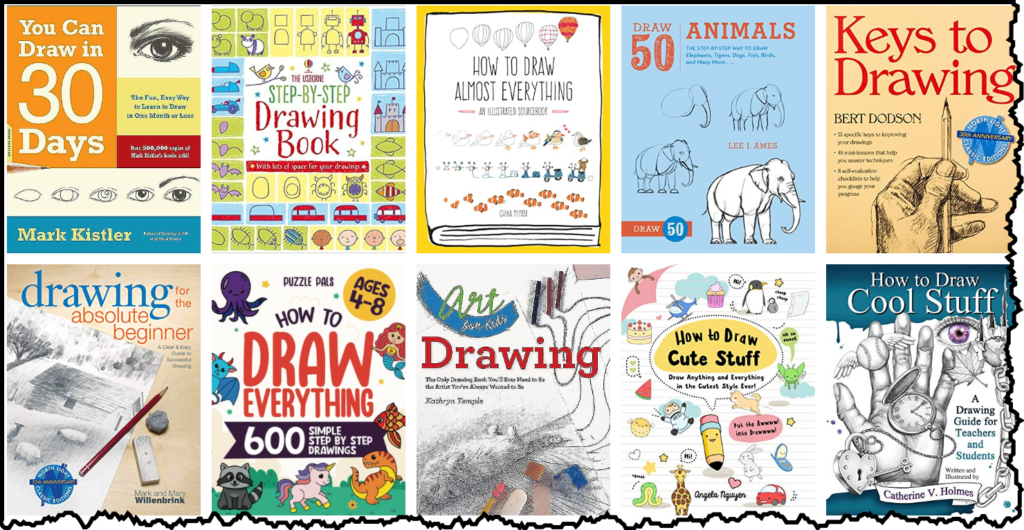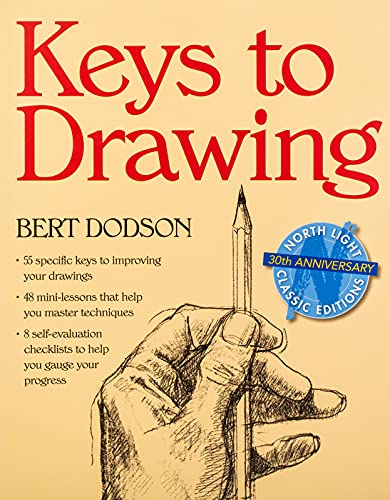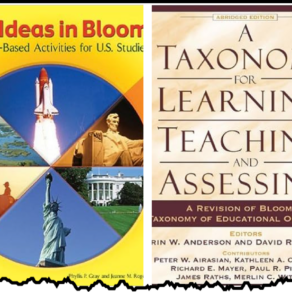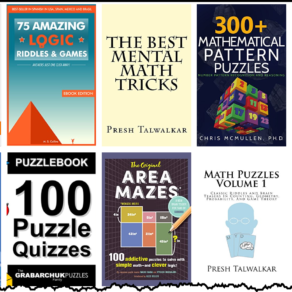Best books on learning how to draw is the topic of our blog post today!
Drawing, as an expressive medium, offers a unique gateway into the world of imagination, technique, and self-expression. Recognizing its unparalleled significance in the educational realm, I embarked on an extensive online journey to curate a list of drawing books that truly stand out.
From basic sketches to intricate details, from beginners to seasoned artists, these books are carefully chosen to cater to diverse artistic inclinations. Through these handpicked gems, my hope is to provide aspiring artists with the tools they need to embark on their own journey of discovery, creativity, and self-expression.
Best Books for Learning How to Draw
Here are our top picks for best books for learning how to draw:
1. 30 Days Learning to Draw, by Erik Barrett
30 Days Learning to Draw, authored by Erik Barrett, is the quintessential guide for beginners looking to set a consistent drawing routine. Emphasizing the importance of practice, Barrett maps out a 30-day schedule that combines theoretical learning with hands-on exercises.
Readers will explore and hone their skills on a variety of subjects, ranging from nature and animals to human features. The user-friendly instructions, coupled with vivid illustrations, make it easier for budding artists to visualize and replicate. Furthermore, with dedicated sections to document your journey, this book isn’t just a tutorial – it’s an interactive experience.
2. How To Draw Everything: 600 Simple Step By Step Drawings For Kids Ages 4 to 8, by Bryce Ross
Stepping into the world of drawing has never been more accessible for young artists, thanks to Bryce Ross’ How To Draw Everything. Packed with over 600 delightful images, this book ensures that every child finds something they love to sketch.
Guided by simple, step-by-step illustrations, the book offers a vast range of themes – from ferocious dinosaurs and adorable animals to enchanting mermaids and festive Christmas drawings. Tailored for children aged 4 to 8, the large print pages ensure easy viewing, and the inclusion of a bonus e-book only adds to the allure. .
3. Art for Kids: Drawing, by Kathryn Temple
Kathryn Temple’s Art for Kids: Drawing stands as a testament to the notion that art is a reflection of the world as we see it. Designed for children, the book is rooted in the fundamental desire to capture the essence of a subject.
Starting with basic contour drawing techniques, Temple delves deep, imparting lessons on creating shapes, using light to depict volume, mastering perspective, and accurately representing various subjects. The systematic lessons are enriched with stimulating exercises, allowing kids to practice and perfect their craft. From people and animals to landscapes, this guide arms young artists with the tools and techniques to render their visions onto paper with accuracy and flair.
4. How to Draw Cute Stuff, by Angela Nguyen
For everyone who’s been in awe of all things adorable, Angela Nguyen’s How to Draw Cute Stuff serves as a delightful manual to create kawaii art, a style deeply embedded in Japanese culture. Nguyen introduces readers to the charming world of kawaii – characterized by simple shapes, oversized eyes, and endearing expressions.
The book is more than just about drawing; it’s about breathing life into everyday objects, bestowing them with emotion and character. Whether it’s animals, mythical creatures, or everyday items, the step-by-step sequences make the drawing process effortless and enjoyable, allowing even beginners to produce captivating art.
5. How to Draw Cool Stuff, by Catherine V Holmes
Catherine V Holmes’ How to Draw Cool Stuff is not just a drawing guide but a journey into the depths of one’s artistic mind. Through a series of elementary illustrations and steps, readers are introduced to the basics of drawing, which then gradually build up to more intricate artworks.
The power of this book lies in its ability to teach viewers to perceive everyday objects through the lens of an artist, transforming the mundane into awe-inspiring art. From lifelike portraits to themed artworks and tattoo illustrations, Holmes makes the complex art of drawing both accessible and immensely enjoyable. Catering to a wide age range, this book is not just about honing your drawing skills but also about discovering the sheer joy that the art form brings.
6. How to Draw People: Step-by-Step Drawings! by Barbara Soloff Levy
Venturing into the realm of human figures, Barbara Soloff Levy’s How to Draw People provides an insightful guide for budding artists. Designed for children aged 5 to 10, this book breaks down the intricate process of drawing people into manageable and easy-to-follow steps.
With 30 diverse images that span professions and activities – from astronauts to roller-skating kids – the book ensures a comprehensive learning experience. The instructions are further enriched by step-by-step illustrations and blank practice pages, allowing children to practice and perfect their craft. Once complete, young artists can even color their masterpieces, adding a personal touch. Part of Dover’s renowned How to Draw series, this book promises not just skill development but also hours of endless fun, making it an ideal gift for young creatives.
7. Drawing for the Absolute Beginner, by Mark Willenbrink, Mary Willenbrink
For those venturing into the intricate world of realistic drawing, Mark and Mary Willenbrink’s Drawing for the Absolute Beginner is the beacon you’ve been seeking. While drawing might seem intimidating, this book breaks down the craft into digestible pieces, making it accessible and enjoyable.
Starting from the absolute basics—like choosing the right materials and mastering the pencil grip—the Willenbrinks guide readers through more nuanced techniques, such as perfecting proportions, mastering perspectives, and creating compelling compositions.
The hands-on exercises peppered throughout the book, culminating in detailed step-by-step demonstrations, ensure readers not only understand the concepts but can apply them confidently. Whether you’re young or old, this book proves that it’s never the wrong time to embark on your artistic journey and experience the sheer joy of drawing.
8. How to Draw: Easy Techniques and Step-by-Step Drawings for Kids, by Aaria Baid
Crafted for the young and budding artist, Aaria Baid’s How to Draw melds imagination and technique, empowering kids to transform their visions onto paper. Beginning with foundational drawing principles—like shading, perspective, and proportion—this guide takes its readers on an artistic voyage.
From captivating magical creatures and animated cartoons to lifelike landscapes and portraits, children get a taste of a wide array of subjects, all while building on their skills. The book’s structured approach, characterized by straightforward instructions paired with detailed illustrations, ensures that each project feels achievable. Beyond just a drawing guide, Baid’s book is an invitation to explore, experiment, and express, making the art of drawing both an educational experience and a delightful adventure.
9. Keys to Drawing, by Bert Dodson
Unlock the world of drawing with Bert Dodson’s groundbreaking guide, Keys to Drawing. Presenting a comprehensive system, Dodson introduces readers to fifty-five foundational “keys” that promise to transform anyone into a skilled artist.
These principles, paired with a myriad of practice exercises, equip artists, even those at the beginner level, to tackle any subject confidently. Dodson delves deep into the artistic process, teaching readers how to fine-tune their focus, harness their hand movements, and effectively convey illusions such as light, depth, and texture.
But beyond the techniques, this book also emphasizes the significance of “creative play,” nurturing an artist’s imagination and innovation. With Dodson as your guide, not only will you master the art of drawing, but you’ll also learn to see the world through an artist’s lens.
10. Draw 50 Animals, by Lee J. Ames
Lee J. Ames brings to life fifty mesmerizing animals ranging from the majestic lion to the nimble bunny in Draw 50 Animals. Designed for aspiring artists, this book offers a unique approach to sketching that’s been honed over three decades.
Ames’s technique, part of the renowned Draw 50 series, has guided countless individuals, from novices to advanced learners, through the intricate art of drawing. His method doesn’t just teach you how to replicate animals, but imparts a deeper understanding, turning the artistic process into a joyful experience and helping budding artists discover their potential.
11. How to Draw Almost Everything, by Chika Miyata
Chika Miyata presents a comprehensive visual treasury in How to Draw Almost Everything, showcasing over 2,000 images. Covering a vast array of subjects—from people and their emotions to diverse clothing styles, from everyday objects to various vehicles—this guide offers step-by-step instructions tailored for both beginners and seasoned artists seeking a refresher.
Miyata sprinkles in engaging challenges throughout the book, like drawing a bustling zoo or maintaining an illustrated food journal, promoting not just learning but also application. This book stands out as a valuable resource, especially for those looking to dive deep into the world of illustration and cartooning.
12. Step-by-step drawing book, by Fiona Watt
Fiona Watt’s Step-by-step drawing book simplifies the artistic process, enabling children to grasp and apply fundamental drawing skills to depict animals, people, and various objects.
With clear instructions guiding them at every step, young artists also have ample space to practice and nurture their own creative flair, making the journey of drawing as interactive as it is instructive.
13. You Can Draw in 30 Days, by Mark Kistler
Mark Kistler, an Emmy award-winning PBS host, invites you to unleash your inner artist in You Can Draw in 30 Days. Debunking the myth of innate talent, Kistler emphasizes that drawing is a skill anyone can master—with the right guidance.
Committing just twenty minutes a day, readers can embark on a transformative journey, progressing from simple sketches to sophisticated 3-D renderings. Kistler’s structured lessons, bolstered by over 500 line drawings, cover everything from basic shapes to intricate human features. He introduces the 9 Fundamental Laws of Drawing, vital for creating depth, and showcases 75 student illustrations as sources of inspiration. Dive into this book, and in a month, marvel at how far you’ve come.
Final thoughts
Drawing is more than just lines on paper—it’s a reflection of our inner world, a tool for communication, and a means to capture the beauty of the world around us. These carefully curated selections represent some of the best books for learning how to draw, tailored to guide budding artists on their journey of creativity. Whether you’re just starting out or looking to refine your skills further, these resources are invaluable in honing one’s craft.



















